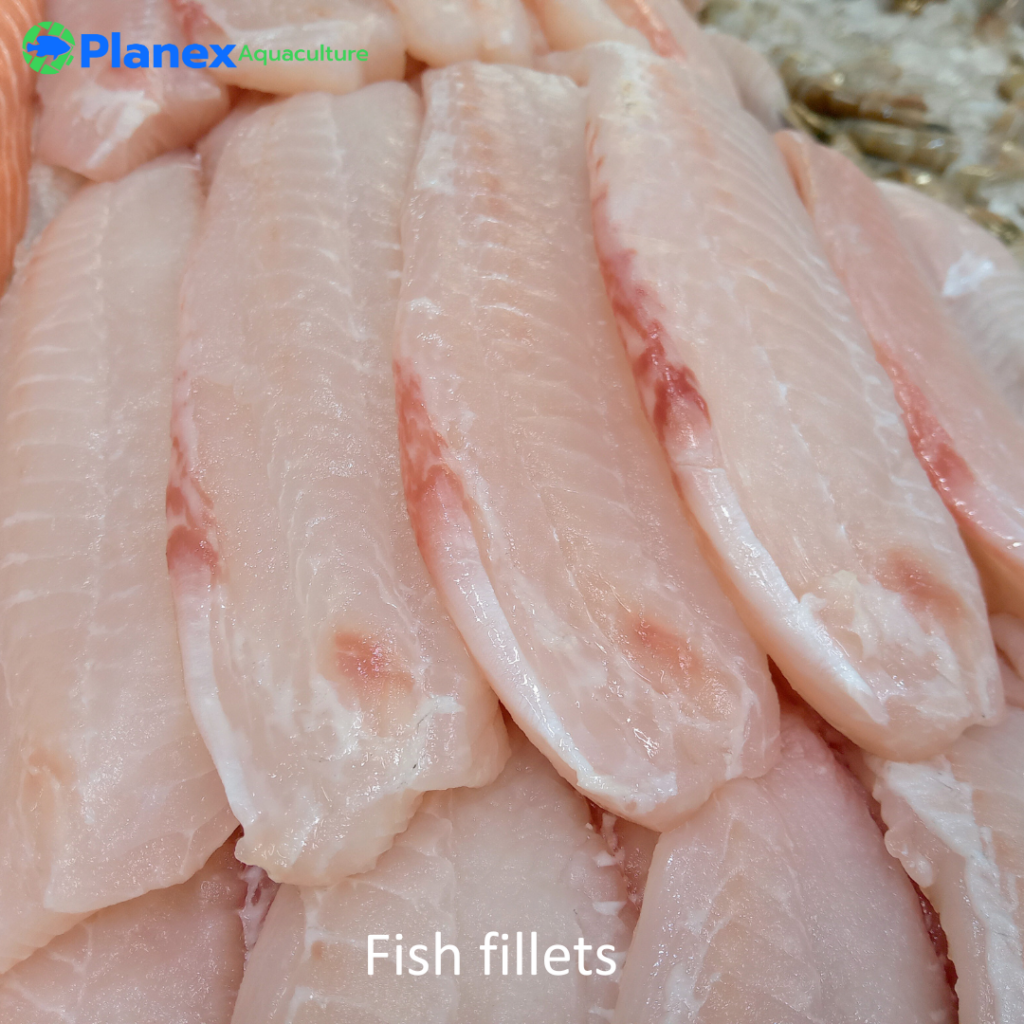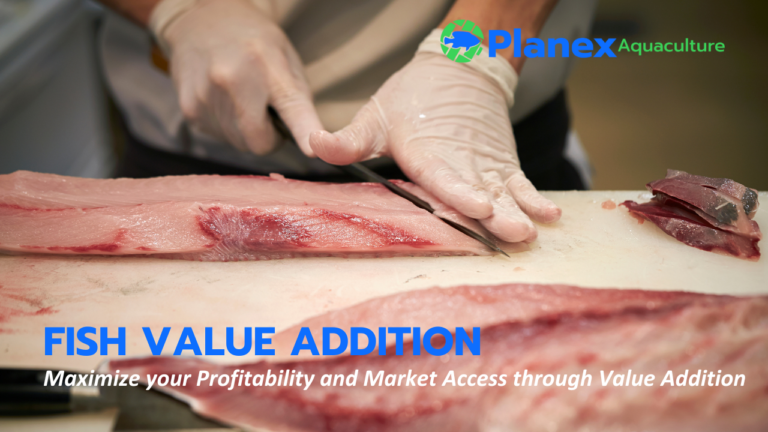Fish farming, or aquaculture, is a vital sector in East Africa, providing livelihoods for millions of people, over 5.3 million people in Uganda. (1) Countries like Uganda, Kenya, and Tanzania have seen significant growth in aquaculture, largely driven by increasing demand for fish as a source of protein. However, many farmers struggle to realise the full potential of their fish farming operations, often due to limited market access, high post-harvest losses, and fluctuating prices. A key solution to these challenges is fish value addition, which can significantly increase profit margins and reduce losses.
In East Africa, post-harvest losses in the aquaculture sector range from 10-20% due to poor handling, processing, and storage practices. By adding value to fish products, farmers can not only extend the shelf life of their harvests but also access higher-value markets. In this blog, we shall explore the concept of fish value addition, the opportunities it presents for farmers, and practical steps for implementing value addition techniques.
What is Fish Value Addition?
Fish value addition refers to any process that increases the market value of fish beyond its raw, unprocessed form. It can include basic techniques like gutting, filleting, and freezing, or more advanced processes like smoking, drying, canning, or creating fish-based products like fish meal or fish oil.
The primary goals of fish value addition are;
- Increasing product shelf life: through drying, smoking, or freezing, the fish is preserved longer.
- Improving marketability: processed fish products appeal to a wider range of consumers.
- Increasing profitability: value-added products often command higher prices in the market.
- Reducing post-harvest losses: by processing fish immediately after harvest, farmers can reduce spoilage rates.
Benefits of fish value addition
1. Increased Profit Margins
Fish value addition significantly enhances profitability. For instance, smoked fish, which is popular in both local and regional markets, can sell for 50% to 100%, and even more than fresh fish. Adding value can therefore increase a farmer’s return on investment.
| Fish Product | Market Price (UGx) | Shelf Life |
|---|---|---|
| Fresh | 7,500 – 10,000 | 2-3 days |
| Smoked | 15,000 – 25,000 | 2-3 months |
| Dried | 10,000 – 15,000 | 3-6 months |
2. Extended Shelf Life
Raw fish, especially in tropical climates, spoils within days if not properly refrigerated. By smoking, drying, or salting the fish, farmers can extend its shelf life to months. This not only reduces losses but also provides flexibility in selling the fish when prices are higher.
3. Access to New Markets
Value-added fish products such as fillets, fish powder, or smoked fish can appeal to urban consumers and export markets. These markets often pay a premium for processed fish due to its convenience and longer shelf life. Exporting dried fish to neighbouring countries like Kenya, Rwanda, South Sudan, and DR Congo offers new business opportunities. Some fish from Uganda is processed and exported to the European market.
4. Reduction in Post-harvest Losses
Post-harvest losses in the fish sector are a major issue, especially in remote areas with limited access to cold storage and efficient transportation. Processing fish into dried, smoked, or canned products helps reduce spoilage and ensures that more of the harvest reaches consumers.
5. Enhanced Food Security
With value-added products, fish farmers contribute to local food security by offering preserved, ready-to-eat fish products that are accessible throughout the year. These products are also nutritionally rich, contributing to improved diets in all communities.
Fish Value Chain Techniques
a) Smoking
Smoking fish is one of the most common value addition techniques in East Africa. It is particularly popular in Uganda, where tilapia and catfish are smoked and sold in local markets. Smoking enhances the flavour and significantly extends the fish’s shelf life.
– Equipment Needed: Traditional or modern smoking kilns (e.g., Chorkor or Altona kilns).
– Shelf Life Extension: 2-3 months.
– Popular Markets: Local and regional (e.g., Kenya, South Sudan).
Smoked fish is not only sold on the local market but also exported to regional markets. For instance, Uganda exports significant quantities of smoked fish to DR Congo and Rwanda, where there is high demand for processed fish products.

b) Drying and Salting
Drying fish, often in combination with salting, is a low-cost method of preservation. This method is commonly used in coastal regions of Kenya and Tanzania. Fish is either sun-dried or dried using solar dryers, which are becoming increasingly popular due to their efficiency and hygiene.
– Equipment Needed: Solar dryers, drying racks, salt.
– Shelf Life Extension: 3-6 months.
– Popular Products: Dried tilapia and catfish.
In East Africa, dried fish is a staple food product in many households and is often sold in rural and urban markets.
c) Fish Filleting
Fish filleting involves removing the bones, skin, and other inedible parts to produce boneless fish pieces that are more appealing to consumers. Fish fillets have high demand in restaurants, hotels, and supermarkets.
– Equipment Needed: Filleting knives, vacuum packaging machines (for storage).
– Shelf Life Extension: 1-2 weeks (refrigerated), up to 6 months (frozen).
– Popular Markets: Urban supermarkets, restaurants, and exports.
Filleting offers a way for farmers to cater for the needs of middle- and high-income consumers who prefer the convenience of ready-to-cook fish.
d) Canning
Canned fish products are a growing industry in East Africa, although they require higher capital investment. Products like canned Tilapia and Nile perch are gaining popularity due to their long shelf life and ease of transport. Currently, the canning method of fish preservation has not yet been applied in Uganda.
– Equipment Needed: Canning machinery, sterilisation equipment.
– Shelf Life Extension: 1-2 years.
– Popular Markets: Export markets, urban supermarkets.
Canning allows farmers to tap into both domestic and export markets, particularly in regions where fresh fish is scarce or expensive.
e) Fish Meal and Fish Oil production
Fish meal and fish oil are valuable by-products produced from fish waste or underutilised fish species. These products are used in both animal feeds (particularly for poultry and fish farming) and human supplements.
– Equipment Needed: Fishmeal production plants, oil extractors.
– Shelf Life Extension: 6-12 months.
– Popular Markets: Aquaculture farms, livestock farms, health supplement manufacturers.
Challenges in Fish Value Addition
Despite the numerous benefits, fish value addition comes with several challenges that limit its adoption by fish farmers, most especially small-scale farmers:
High Initial Investment: Equipment such as smoking kilns, freezing rooms, filleting equipment, and canning units can be expensive for medium and small-holder farmers.
Lack of Technical Skills: Processing fish requires training to maintain hygiene, safety, and quality standards, which some farmers may lack.
Market Access: Although value-added products have the potential to reach new markets, navigating logistics, market regulations, and distribution channels can be complex processes.
Infrastructure Needs: Reliable power, clean water, and cold storage facilities are necessary for producing and storing value-added fish products, but these are often lacking in rural areas.
Practice Tips;
1. Start with Low-Cost Options: Begin with basic value addition techniques like sun-drying, salting, or traditional smoking. As your business grows, invest in more advanced equipment.
2. Build Capacity: Seek out training programs to learn best practices for fish processing, hygiene, and quality control. Many organisations in East Africa, such as the Uganda Fish Processors and Exporters Association (UFPEA), offer capacity-building programs for fish farmers.
3. Explore Funding Opportunities: Fish farmers can also apply for grants or low-interest loans to invest in value addition equipment. Programs like the Agricultural Business Initiative (aBi) and Uganda Development Bank offer financial support for agricultural projects.
4. Leverage Cooperatives: Joining or forming fish farmer cooperatives can potentially enable small-scale farmers to collect necessary resources to access processing equipment and sell products in larger markets.
5. Focus on Quality: Ensure that your value-added products are produced under hygienic conditions to meet both local and international market standards.
6. Target Niche Markets: Try exploring urban and export markets for value-added products like smoked fish, dried fish, and fish fillets. Researching market demand and aligning production to consumer preferences is essential to success.
Fish value addition represents an opportunity for increasing the profitability, sustainability, and marketability of fish farming in East Africa. By reducing post-harvest losses, extending shelf life, and tapping into higher-value markets, farmers can significantly enhance their incomes and improve the livelihoods of their communities. While there are challenges to overcome—such as the need for capital investment and technical training, the potential returns far outweigh the risks.






